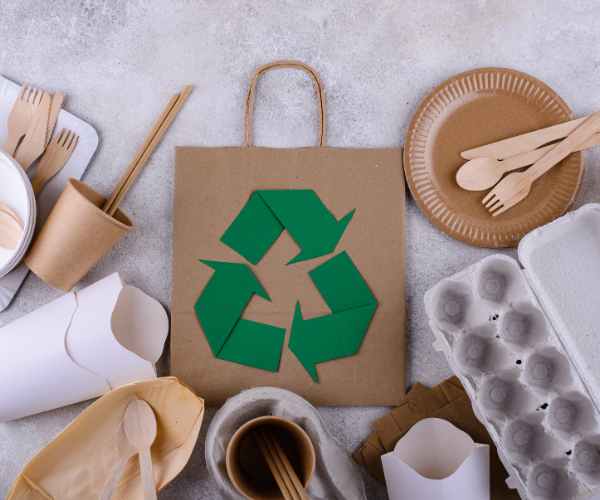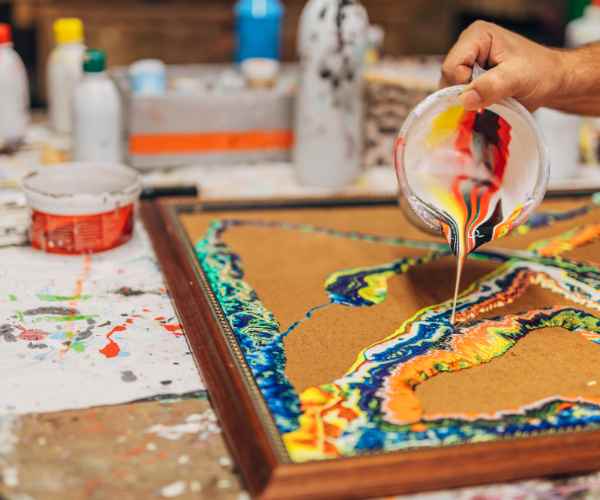The sustainability part of the design is affecting trends in different sectors.
Want to know what it means?
Instead of viewing only from the perspectives of beauty and utility, sustainable design envisions aesthetics that care for the people and the world around them.
It can be viewed as an ethical consideration of the environment and social issues that takes place at each stage of the designing process.
As consumers, our concern regarding the consequences of our decisions is at the highest level ever.
With this consumer concern brands are starting to shift focus on sustainability.
Take, for example, Patagonia.
From the very inception of the brand, its goal has been to practice sustainable approaches such as giving their brand clothes made from recycled materials, and promoting their customers to repair and reuse the equipment they have.
Rather, their philosophy stands in the center of their audience, so it is not just a marketing gimmick that they’re after.
IKEA, which aspires to be climate positive by 2030, is another excellent illustration.
They are developing more sustainable materials to use in their products, as well as creating covers that are easier to recycle.
These examples in specific illustrate how sustainability is becoming intertwined in design in 2024 thus paving the way for an interesting conversation about the different trends that are coming up.

The Growing Importance of Sustainable Design
So, let’s take a closer look into the meaning of the term sustainable design. The definition of “sustainable design” implies an approach aimed at the environment protection and running the economy. It means working for the cause and creating products, processes, or places that do not have a negative effect on the society and the economy. It’s the idea of making sure that what we do so not injure future generations. In this context, consider the design practices that have prevailed in the entire industry for centuries. In many of them, the profit was placed above all else, causing environmental damage on a large scale. Nonrenewable resources were most often used; waste production during processing was huge. One example which is bitter but I think the best is Nespresso.
The corporation faced criticism not long ago about the massive waste caused by its aluminum coffee pods. They have had to alter their position on the issue and have attempted to be more responsible and environmentally friendly. They began a recycling program through which customers can send back used pods for post-consumer recycling and are now making coffee from sustainably sourced beans. Also, Nespresso launched as an industrial design coffee machine that came with the promise of better tasting coffee to its consumers. This transition not only reconstructed Nespresso but showed how a company takes responsibility for the impact of its actions on the environment.
Factors Responsible for The Growth of Sustainable Design
So, what exactly is responsible for the increased focus on the concept of sustainability in design in 2024?
To start off, there is an increasing pool of consumers who prefer to use environmentally friendly products.
The public is becoming conscious about their selection and are making make concerted efforts in choosing specific brands that meet their preferred objectives.
To illustrate, a study published recently showed that more than 70% of consumers are prepared to spend more for the sake of using sustainable and environmentally friendly products.
Hence, this transformation is requiring businesses to reassess the way they conceptualize new designs.
Changes in the business regulatory environment has also aided this movement.
Most countries are enacting stricter regulations targeted at reducing waste and increasing sustainability.
In the example of the European Union, the Green Deal is seeking to introduce new legislation around standards on products and packaging in order to make companies to be more sustainable.
These advances center on progress — not merely compliance. In fact, they are helping to engender an inventive spirit in businesses.
And of course, statistics!
New studies show that the trend toward sustainability is ever more reaching zenith and searches for products of this type have never been so popular.
And the thing is, this is not a random trend, it is global self awareness that emphasizes sustainability as key to design.
While considering ideas for sustainable design trends to be developed in 2024, let’s remember that sustainability is already rapidly becoming an indispensable issue for brands seeking competitiveness in the global market.
Here are some innovative ideas trending for 2024 in sustainable design.
Circular design
I am thrilled by the concept of circular design since it alters the way we approach production and consumption on all levels of the supply chain.
The definition of circular design revolves around the establishment of a system that allows products to be repaired, reused, and recycled instead of being disposed of after their first use.
This concept matters because it is a departure from the normal and widely accepted “take, make, dispose” practice.
It empowers us to have entirely new thoughts on how we relate to materials and resources.
Eileen Fisher is leading the way in circular design within this garment sector.
Their Renew program takes old garments and sells them after refurbishment enters itself.
This would not only reduce wastage but also increase the sustainability of the fashion world by increasing the lifespan of their products.
Patagonia is a great example to put it into perspective as they offer repair services for their outdoor clothing and equipment so that consumers are encouraged to fix them rather than to buy new ones.
The approaches discussed reveal how circular design can reduce waste and needless consumption of resources and pave the way for a more sustainable future.
Biophilic Approach
Now talk about biophilic approach of design.
There is a link between people and the nature and it is due to certain design and approach that is rather an innovative one.
In a Biophilic Design, natural components such as light, plants, and water are included in workspaces so as to have them look and feel good while also having a positive effect on the users’ health.
For instance, picture yourself entering an office that is bright and filled with indoor plants.
Doesn’t this seem more motivating than a dark cubicle with no windows? Biophilic Design or Nature-centered Interior Design definitely boosts mood and productivity as well as ensures general wellness.
The best and commonly known example of this is the One Central Park project in Sydney Australia that features a vertical garden constructed by well-known landscape architect Patrick Blanc.
These living walls are said to also improve the quality of air apart from looking good.
Nature has always been my best friend.
I recall the first time I went to one coffee shop where there was a garden in an indoor setting, a water fall and lots of colored plants.
I remember it so well, the place turned out to be ideal where I could both concentrate and calm my mind at the same time.
Biophilic approach of design is remarkable for certain reasons like it reminds people of nature which is normally buried beneath concrete setting.
Purpose Driven Minimalism
The Last one is purpose-driven minimalism, a trend that takes care of the planet without taking care of the looks.
The goal of a product that is made on minimalism principles in a sustainable model is to create a design that is simple, useful and with no extra features.
This is about considering what you are doing and selecting a better or more desirable option at a given time.
Muji is an excellent company since its products are designed for minimalism use purposes, while the materials and the production processes are also eco-friendly.
Their strategy is best encapsulated by “no-brand quality goods,” which translates to: Find a need and fill it, no more decoration.
In fact, the wonderful part about minimalism is that it motivates us towards possessing a lesser number of items and valuing more what one has.
A few years back, when I decided to get rid of a few things from my room, it was the most amazing feeling of freedom I ever felt.
Getting rid of such items was a bit of a relief because they don’t do anything valuable for me anymore.
I began to purchase a few beautiful items that were real life changers rather than a waste of money.
Sustainable options begin to change paradigms where lesser truly wins and so we make conscious choices on what enters our sphere.
The Role of Technology in Sustainable Design
Now let’s look at how technology is integrated into sustainable design practices.
In the velocity recurrent of today’s world, technology becomes a key enabler in the resolution of issues caused by climate change.
Thanks to smart materials and digital design tools, the designers are easily able to integrate sustainable practices into their processes.
If for example a wide spanning company like Interface can use their technology to make carpet tiles out of recycled materials then great strides can be made towards reducing the carbon footprint left behind by any company.
The collection of old fishing nets as part of the Net-Works initiative so that they can be made into carpets is an example of this.
In addition to providing economic opportunity in coastal regions, this strategy eliminates waste completely.
The application of 3D printing techniques for design is also fascinating, and this strategy will go a long way toward advocating for sustainability.
Sustainable design is on the verge of a major transformation thanks to this advance.
For example, a 3D-printed water filtration system was created by Tangible Media Group at MIT.
These devices can be printed using fewer materials and can be easily assembled or taken apart for maintenance and repairs.
Amazing how the New Age in Design is being shaped by these developments allowing us to collaborate towards sustainable design.
FAQs
What is sustainable design?
It is an integrative approach to design that seeks to minimize the predicted negative effects of design on the environment and society as a whole.
It’s focused on developing products, buildings, or systems that are friendly to the environment, socially acceptable and can be profitable in the long run.
Envision it as a means that guarantees that the design options that we have today will not interfere with the capability of the future generation to fulfill their needs.
The modern context in which sustainable design extends cannot be put in a more enthusiastic way.
While environmental issues such as climate change, overexploitation of resources and pollution are becoming a pressing reality, the very crux of sustainable design is to come up with ideas that seek to tackle these issues.
No, it is not a passing fad; it is a paradigm shift on how such processes should be approached. It is organic.
But why is sustainable design important?
Well, as said, the value of sustainable design goes beyond just being able to make spaces look pleasing, it has great implications for profit making in the businesses and the environment as well.
For firms, sustainable design can help businesses save money by being more efficient with resources and reducing waste.
Unilever and many others have already achieved that and will achieve that with reported savings during the implementation of these practices, it is what they need exclusivity for the items that are environmentally friendly.
On the contrary, sustainable design serves the needs of helping in the reduction of products and processes carbon emissions.
It advocates the utilization of renewable resources use, recycling and reduction eco waste for a better world for everyone.
But it’s not only about figures, it’s also about effecting change for the better.
The companies that take sustainability as a priority are still few, however, I do see a movement in such companies doing business in a more humane manner which is able to see us all as part of the world and not separate from it.
How can firms implement sustainable design approaches?
Adopting sustainable design strategies may look like a big challenge but it doesn’t necessarily have to be that way.
For businesses wanting to make a change, the following are some practical, actionable steps:
Assess Current Practices: Identify present practices and begin to analyse the potential for enhancing existing practices as well as new areas.
Set Clear Goals: Define sustainability objective targets and indicators. For example lowering waste, application of biomass and green materials or enhancing energy efficiency.
Engage Stakeholders: Get employee and customer and supplier participation to this effort.
Working together can help the organisation find better ways of meeting its sustainability goals and create a sustainable culture in the company.
Invest in Sustainable Materials: Determine sustainable materials needed for your design needs and find suppliers of such materials.
Notable brands like Allbirds have benchmarked the sustainability mark by employing the use of natural materials such as merino wool and eucalyptus fibers.
Educate and Train Staff: Training staff is important in making them responsive and alert on best practices about sustainability especially in design.
Maintain Sustainability- Understand that this is a continuous process, collect feedback, amend objectives where necessary. Assess strategies, outcomes and goals on a regular basis.
Focusing on particular practices will ensure that the organization is heading towards incorporating sustainable design practices which would in turn be of great use to the profits made alongside sustaining the environment.
What are the trends that can emerge from the sustainable design for the year 2025?
From discussion trends relating to sustainable design for the year 2024, we can identify a few themes that stand out:
Recycling Brought to Life: This principle advocates the new products to be crafted out of the already existing products and even encourages the new product to be constructed from the already constructed products in order to minimize the environmental footprint and expand the existence time of the products.
Biophilic Design: It is the processes that make use of natural components in the designs with the goal to generate the surroundings for the consumers for on them to feel safe, cared for, and connected to nature.
PurposeDriven Simple Consumerism: This phenomenon is rooted in the idea of making use of only what is required, for the consumer to change his or her perception towards buying goods or services with increased importance.
Technological Innovations: Making use of technologies Today, the use of 3D printers and other smart design solutions pushes the boundaries of Biomimicry further and greater emphasizing on sustainability and enhancing production efficiency.
It is evident these patterns are going to be embraced by the industry since it signifies a needed change towards a more responsible and considered attitude to designing for a consumer in an era that is thirsting for environmentally friendly products.
Conclusion
To conclude the issues above deserve greater attention in the future of the design, for a designer in 2024, its clear trends are fruitful and progressive.
For brands that want to do well in an environmentally concerned world, sustainable design is no longer an option, but instead a must.
As time goes on, the need for sustainability continuously gives direction to the future of design, nurtures creativity and new concepts that are favorable for both the planet and its people alike.
I urge you to think about the ways in which sustainable design can influence the ideas behind your purchases and your projects.
Every little deed is a part of a bigger picture, be it buying a product that was made out of environmentally friendly materials or rethinking a design in an environmentally conscious manner.
I would like to encourage discussion!
The trends in the field of sustainable design shouldn’t leave you indifferent, so please share your opinions with me.
What new aspects in your favorite brands did you notice?
How about your own life, how do you relate it to the ideas of sustainability?
Feel free to post your ideas in the comments section!






